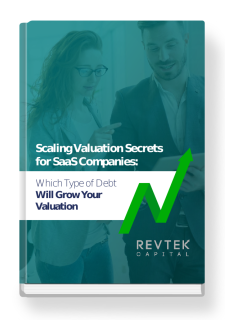When you’re running a SaaS company, one of the most important yet often confusing financial metrics to get right is your Cost of Goods Sold, or COGS. Why? Because it directly affects your gross margin, which in turn influences how investors, lenders, and potential buyers perceive the health and scalability of your business.
However, for SaaS companies, calculating COGS isn’t as straightforward as it is for businesses that sell physical products. There’s no universal playbook. So let’s walk through how to define COGS for your SaaS company, what to include (and what not to), and why it matters.
What is COGS for a SaaS Business?
COGS refers to the direct costs associated with delivering your software to customers. For physical products, this would include raw materials and manufacturing. But for SaaS? It’s the infrastructure, people, and tools required to keep your SaaS platform running.
No GAAP standard outlines what should or shouldn’t be included in SaaS COGS, which means how you define it can significantly affect your gross margin. And that gross margin is a key signal to investors about the sustainability of your business model.
COGS vs. Operating Expenses: What’s the Difference?
It’s important to separate COGS from Operating Expenses (OPEX). Think of it this way:
- COGS = Costs that are necessary to deliver your product.
- OPEX = Costs that help you run and grow the business, but aren’t essential for the product to function.
If you can deliver your software without incurring a certain cost, it probably belongs in OPEX, not COGS.
What Should Be Included in SaaS COGS?
Here are the core cost categories typically included in SaaS COGS:
1. Hosting amp: Infrastructure
This is often the biggest line item. If it keeps your platform online, it belongs in COGS.
- Hosting
- Storage and bandwidth costs
- Load balancing, monitoring, and performance tools
- Third-party tools that are required for functionality
If customers can’t access your product without it, include it.
2. Customer Support amp: Success Teams
If someone on your team is helping customers use the product, troubleshoot issues, or onboard effectively, their work directly supports the service.
- Technical support teams
- Onboarding and implementation specialists
- Customer success managers (focused on retention, not upselling)
You can also include fully burdened compensation: salaries, benefits, payroll taxes, and even training, if these employees are directly tied to product delivery.
3. DevOps amp: Site Reliability Engineering
Your product doesn’t run itself. Behind every “always on” software experience is a team keeping things stable.
- DevOps engineers
- Site reliability engineers (SREs)
- Infrastructure-focused developers
If these employees ensure uptime and performance, their costs can be allocated to COGS.
4. Third-Party Software Licenses
SaaS platforms often rely on other SaaS products to function.
- Embedded APIs
- Payment processors
- Messaging infrastructure (Twilio, SendGrid, etc.)
- Licensing fees for essential integrations
If the software helps deliver your product experience, it qualifies.
What Should NOT Be Included in SaaS COGS?
Here’s where companies often overreach. Avoid putting these in your COGS calculation:
- General amp; Administrative salaries (HR, legal, finance, executives)
- Marketing tools or advertising spend
- Product Ramp;D (even though it improves your software, it’s not delivering it)
- Sales commissions or team members focused on upsells
- Office rent, travel for non-service teams, and general overhead
A good rule: if removing the cost wouldn’t interrupt the customer experience, keep it in OPEX.
Why Does COGS Matter So Much?
Your gross margin is calculated as:
Gross Margin = (Revenue – COGS) / Revenue
Most SaaS investors look for 70–90% gross margins. If your COGS is too high, it signals poor scalability and can affect your chances of securing funding or achieving a strong valuation.
Here’s what clear, consistent COGS tracking helps with:
- Investor Confidence – Lenders and VCs want to see high margins and operational efficiency.
- Accurate Forecasting – Understanding unit economics allows you to scale smarter.
- Exit Strategy – When it’s time to sell, buyers want a clean P&L with transparent cost allocation.
If your margins are off, it could be a sign that your infrastructure costs are too high, your support team is bloated, or you’re classifying expenses incorrectly.
Why It Pays to Get COGS Right
COGS is more than a financial metric; it’s a reflection of how efficiently you deliver your product. Getting it right helps you measure profitability, tell a better story to investors, and prepare for scale.
At RevTek Capital, we work with SaaS companies to not only fund growth but to help founders better understand the key metrics that make a difference. Whether you’re preparing for a financing round, planning an expansion, or getting your financials investor-ready, our team is here to help you build a stronger foundation.
Why Founders Choose RevTek Capital
Our approach is simple: We fund innovative founders with growing companies.
We provide growth capital ranging from $2 million to $20 million to SaaS companies generating $5 million or more in annual recurring revenue (ARR). With our funding, founders can:
- Expand into new markets and scale operations while preserving equity
- Invest in product innovation and build cutting-edge solutions
- Strengthen sales and marketing strategies for accelerated growth
- Hire top-tier talent to drive competitive advantage
At RevTek Capital, we believe founders should own more of their company at exit, not less. Unlike many venture capital firms that push for aggressive dilution, we provide capital that preserves founder equity while fueling expansion. We structure the terms to provide the capital you need, and when ready, you can add more quickly.
Looking Ahead: The Future of SaaS Funding
The SaaS industry is evolving at an unprecedented pace and opening new frontiers for software innovation.
At RevTek Capital, we are committed to fueling the next generation of SaaS leaders by providing the capital and strategic support needed to turn bold ideas into market-leading companies.
If you are a SaaS founder looking to accelerate growth, let’s talk. Your success is our mission.
Let’s build the future of SaaS together



